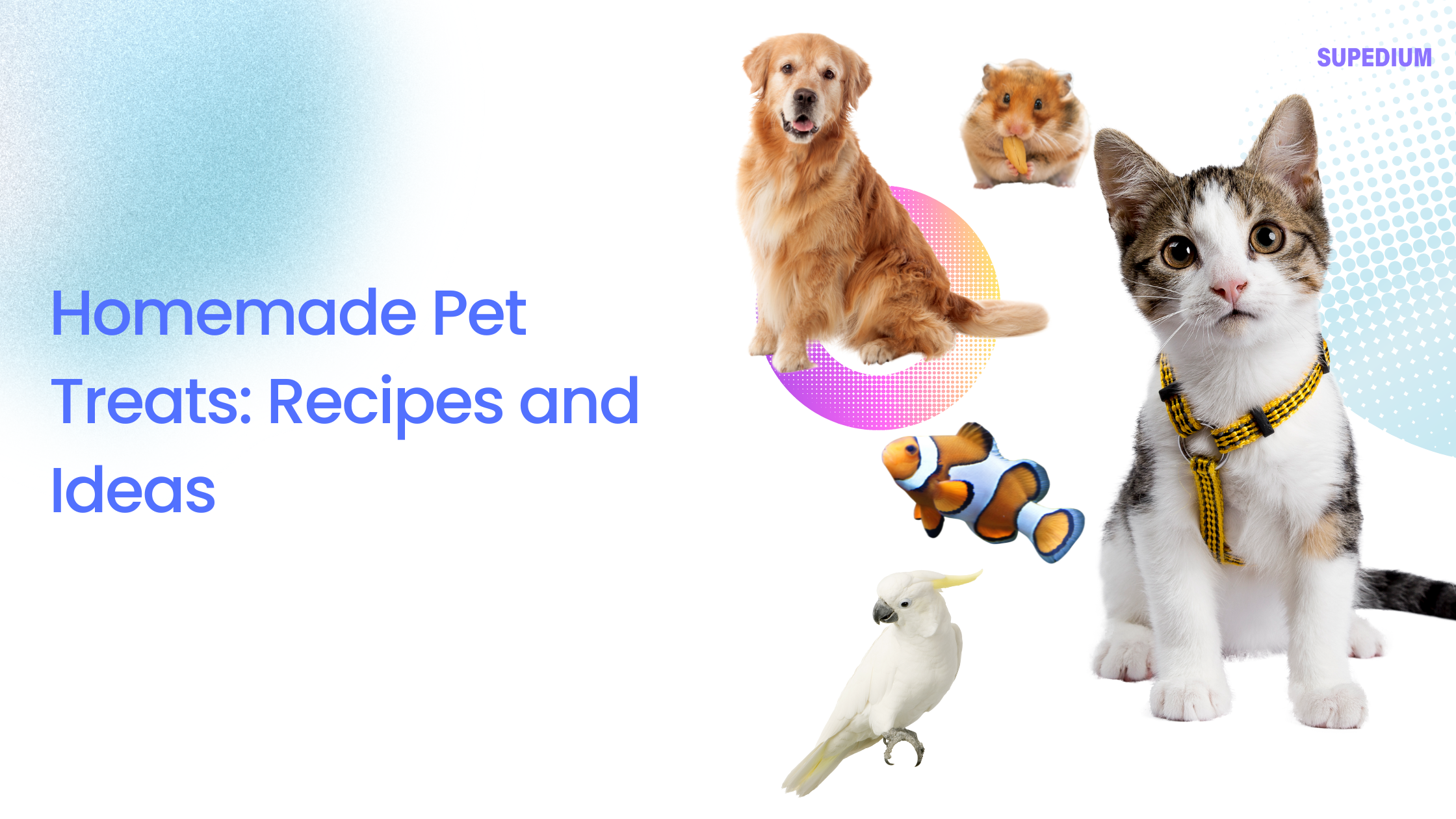Table of Contents
![]()
Homemade pet treats are more than just a tasty reward for your furry friend; they are a way to ensure your pet’s diet is as healthy and nutritious as possible. By making treats at home, you have complete control over the ingredients, which can be especially beneficial for pets with dietary restrictions or allergies. In this guide, we’ll explore the benefits of homemade treats, provide a range of recipes, and offer tips on how to ensure your treats are both delicious and safe.
Understanding Pet Nutrition
Before diving into recipes, it’s essential to understand the basics of pet nutrition. Pets, like humans, require a balanced diet rich in specific nutrients. For dogs and cats, key nutrients include proteins, fats, carbohydrates, vitamins, and minerals. However, the requirements for dogs and cats differ slightly, and each pet may have unique dietary needs based on age, size, and health conditions.
Ingredients to Avoid: Certain foods that are safe for humans can be harmful or even toxic to pets. For example, chocolate, grapes, and onions are dangerous for dogs, while cats are particularly sensitive to certain artificial additives and high-fat foods. Always avoid these ingredients when making homemade treats.
Essential Ingredients for Homemade Pet Treats
For Dogs:
- Whole Grains: Ingredients like oats and whole wheat flour provide fiber and energy.
- Lean Meats: Chicken, turkey, and beef are excellent protein sources.
- Vegetables: Carrots and sweet potatoes are nutritious and easy to digest.
- Fruits: Apples and blueberries can be a sweet and healthy addition.
For Cats:
- Protein Sources: Tuna, chicken liver, and other meats are crucial for a cat’s diet.
- Vegetables (in small amounts): Peas and pumpkin can be included, but cats require less vegetable matter than dogs.
Additional Supplements (Optional):
- Omega Fatty Acids: These can be beneficial for coat health.
- Probiotics: Support digestive health and boost immunity.
Basic Recipes for Homemade Pet Treats
Dog Treat Recipes:
- Peanut Butter and Banana Biscuits
- Ingredients: 1 cup whole wheat flour, 1/2 cup peanut butter, 1 ripe banana, 1 egg.
- Instructions: Preheat oven to 350°F (175°C). Mash the banana and mix with peanut butter and egg. Gradually add flour until the dough is stiff. Roll out, cut into shapes, and bake for 15-20 minutes.
- Sweet Potato Chews
- Ingredients: 1 large sweet potato.
- Instructions: Preheat oven to 250°F (120°C). Slice the sweet potato into thin rounds. Arrange on a baking sheet and bake for 2-3 hours until dried and chewy.
- Chicken and Carrot Bites
- Ingredients: 1 cup cooked chicken breast (shredded), 1/2 cup grated carrots, 1 cup oats.
- Instructions: Mix all ingredients until well combined. Form into small balls and bake at 350°F (175°C) for 20 minutes.
Cat Treat Recipes:
- Tuna and Catnip Bites
- Ingredients: 1 can tuna in water (drained), 1 tablespoon dried catnip, 1 cup whole wheat flour.
- Instructions: Preheat oven to 350°F (175°C). Mix tuna, catnip, and flour until a dough forms. Roll out, cut into small pieces, and bake for 10-15 minutes.
- Chicken Liver Treats
- Ingredients: 1 cup chicken liver, 1 egg, 1 cup whole wheat flour.
- Instructions: Preheat oven to 350°F (175°C). Blend liver until smooth. Mix with egg and flour. Pour into a baking dish and bake for 20-25 minutes. Cool and cut into small squares.
Treats for Both Dogs and Cats:
- Pumpkin and Oat Cookies
- Ingredients: 1/2 cup pumpkin puree, 1 cup oats, 1 egg.
- Instructions: Preheat oven to 350°F (175°C). Mix all ingredients together. Drop spoonfuls onto a baking sheet and bake for 15-20 minutes.
Customizing Treats for Special Needs
Grain-Free Options:
- Ingredients: Almond flour, coconut flour.
- Recipe: Grain-Free Peanut Butter Treats – Mix 1 cup almond flour, 1/2 cup peanut butter, and 1 egg. Form into balls and bake at 350°F (175°C) for 10-15 minutes.
Low-Fat Treats:
- Ingredients: Apples, lean meats.
- Recipe: Apple and Chicken Bites – Mix 1 cup cooked chicken (shredded) with 1/2 cup finely chopped apple. Bake at 350°F (175°C) for 15 minutes.
Allergy-Friendly Treats:
- Ingredients: Single protein sources like venison or duck.
- Recipe: Venison Biscuits – Mix 1 cup ground venison with 1 cup sweet potato flour. Bake at 350°F (175°C) for 20 minutes.
Storage and Preservation
Short-Term Storage:
- Store homemade treats in an airtight container at room temperature for up to a week. This helps retain freshness and flavor.
Long-Term Storage:
- For extended storage, freeze treats. Place them in a freezer-safe container or bag. Thaw as needed and ensure they are fully thawed before giving them to your pet.
Safety and Best Practices
Ensuring Ingredient Safety:
- Always use fresh ingredients and avoid harmful additives. If you’re unsure about an ingredient, consult your veterinarian.
Handling and Hygiene:
- Maintain clean utensils and surfaces while preparing treats. Ensure that treats are cooked to safe temperatures to kill any potential pathogens.
Portion Control:
- Treats should make up no more than 10% of your pet’s daily caloric intake. Adjust the number of treats based on your pet’s size and activity level.
Fun and Creative Treat Ideas
Interactive Treats:
- Stuffed Toys: Fill a durable toy with a mixture of your pet’s favorite treats and kibble for a fun, interactive experience.
- Frozen Treat Popsicles: Blend fruits like blueberries with yogurt and freeze in molds for a refreshing treat.
Seasonal and Holiday Treats:
- Halloween Treats: Shape treats into spooky designs and use dog-safe food coloring.
- Holiday Cookies: Create festive shapes and flavors to celebrate special occasions with your pet.
Conclusion
Homemade pet treats offer a fantastic way to provide your pet with healthy, delicious rewards while ensuring their diet remains balanced and nutritious. By experimenting with different recipes and customizing treats to meet your pet’s specific needs, you can enhance their overall well-being and happiness. Always remember to prioritize safety and consult with your veterinarian when introducing new foods into your pet’s diet.
Share This





Be the first to comment